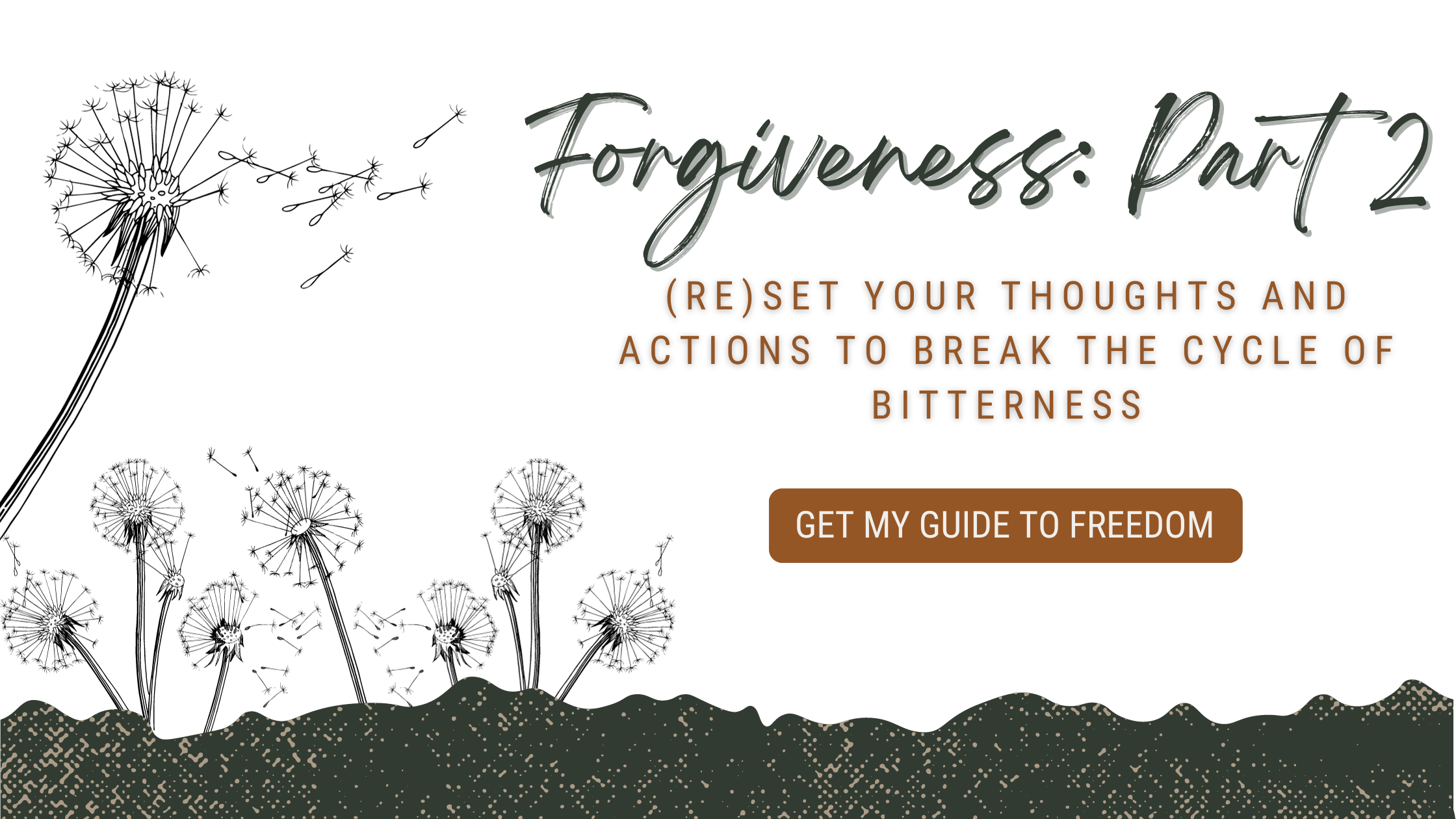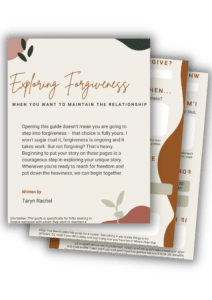(RE)set your thoughts and actions to break the cycle of bitterness
What no one tells you about forgiveness, is that each time you feel ready, you’ll be given a *really good* reason why you don’t want to. There is not just one profound moment where you choose to forgive. It’s both choosing to forgive generally all that has been done and not done. Then it’s preparing to be blindsided by a trigger of unforgiveness. Let’s now narrow in on how to navigate those pesky blindsides.
For the first couple years, my forgiving had taken place without the presence of the person near, but now I was seeing him everyday. My daughter’s dad told me he had gotten a new job that required him to be on call and he would have less time once he got off to come over now. It was as if I was 17 years old again watching him go to college and leave us behind. Immediately, I felt unsettled even though I wanted to be happy for his new opportunity. We were rebuilding our friendship after all. This new schedule began and his time seeing our daughter decreased. One night as he got up to leave, I surprised myself by saying I wanted to talk. As he sat back down, I shared how him being around less made it feel like he was leaving us all over again. It wasn’t that I wanted him to quit his job or that I needed validation. I told him, “I needed to let you know what’s going on in my head so it can lose power and not fester.” This too, was a piece of forgiveness — letting truth ring louder than bitterness even if the conversation’s outcome is unknown.
Isn’t it the ugly truth that our minds don’t always serve us in the way we need, yet we rely on most heavily. It loves quick fixes and will try to make us avoid thinking about pain or only think about pain, enabling us to ruminate on the situation. Any fellow overthinkers??
In that moment where anger takes over, a memory surfaces or a new interaction occurs, remember these three don’ts: 1) DON’T rush past it 2) DON’T push it down 3) DON’T stay stuck in your head. Anytime you don’t make space for pain, you’ll have to make extra space later. And anytime pain gets the only say, it doesn’t leave space for anything else.
Tucked within the story above is a process. This process has pulled me out of resentment and strengthened my relationships over and over again. It’s a picture of forgiveness in practice with a focus on your thoughts, emotions and actions for those moments you’re riled up and wondering what just happened. For those of you who ‘get in your head’, I recommend writing out this process or walking through it with someone else so it can be productive. Let’s get to it!
Resetting Your Thoughts:
1. ACKNOWLEDGE THE TRIGGER and believe it is valid because it stirred up unexpected emotion. Make the decision you’ll find time to give this attention — not rushing past or to avoid uncomfortability.
2a. Find the root. Ask yourself questions like, “what could my response be tied to?” or “what might this be reminding me of?”. My favorite is, “Where the heck did that come from?” HINT: If you notice responses like this one may be a pattern for you, don’t chalk it up to just being hangry.
2b. But wait! What if I can’t identify the root?? That’s okay — sit in this moment. Embrace this experience as information guiding you toward healing. Triggers point to areas begging to be paid attention to. Ignoring it fuels it for later. Tip: Our triggers often creep into other relationships. Maybe this reaction didn’t come from the person you think it did. It’s okay to not know, you can still walk through the other steps!
3. Remember: You have control over your thoughts, and your thoughts and emotions guide your actions. Get clear on the story you are telling yourself about the situation. If your story sounds like, “They don’t care about me. They always do this.” That’s okay. Practice taking that hurtful story and put yourself in control. This may sound like, “I’m so hurt. I know I can’t control their words. I want to let the words roll off and to feel confident again. In order to do that I need X.” Then… feel hurt. Decide what would help you feel confident again. Do that thing. Your needs are important — they feed your healing.
4. Intentional Actions: Asking, “What do I want to do with this?” can help you decide if this is something you want to work through alone (prayer, journal, etc.) or if it deems a conversation with someone else (the person you want to forgive, a therapist, a friend). This step sets you up to be intentional moving forward so you can prepare to show up or have a conversation proactively — not reactively.
5. Now onto forgiving. There is enough grace to cover your unwillingness to forgive AND the other person’s decisions. After all, the reason you wanted to choose forgiveness was so you could get back in the driver’s seat. Allow yourself to receive grace with palms facing up and open. Seriously, right now, face your palms up! Take a deep breath. Ask God to help you forgive what still hurts. Then, try a phrase like, “I’m going to forgive because it helps me to let go, not because what they did was okay.”
*This process assumes there is time in between the harmful instance and your response. For those moments you’re caught in person and blindsided by a situation, give yourself permission to respond with boundaries that let the other person know how you expect to be treated and what you will do if that doesn’t occur.
Now that you’re paying attention to all the hurt that you are forgiving, you may realize how frequently hurt was getting the final say. Following the outlined process equips you to reset your thoughts when resentment creeps in. Any strategy above is a giant leap in the direction of forgiveness, but stacking the steps maximizes self-awareness and intentionality going forward (more practical guidance here).
Forgiving as you go not only frees you to let go of hurt instead of keeping a tally, it also reveals areas that could use healing. There’s people we will never see again or rarely see that we want to forgive. But what about those people we see ALL the time where bitterness has taken root? Communicating hurt and forgiveness can instantly raise red flags for conflict in a peacekeeper mind. But… what if it can also be an opportunity to build a relationship? Click “NEXT” below to read part 3 in this forgiveness series.




